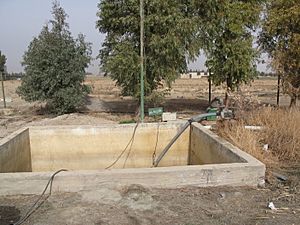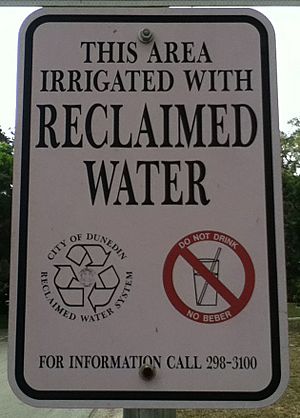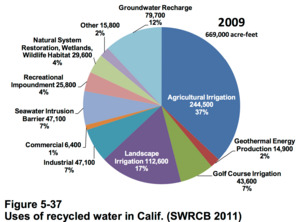Reclaimed water facts for kids
Reclaimed water (also called recycled water or water reclamation) is water that has been used before and then cleaned so it can be used again. This process turns wastewater (water that goes down drains from homes, schools, and businesses) into water that is safe for other uses.
People can use reclaimed water for many things. It can water gardens and farm fields (irrigation). It can also refill natural water sources like rivers, lakes, and underground water supplies (groundwater recharge). Sometimes, very clean reclaimed water can even be used in homes for things like flushing toilets. In some places, it's cleaned so much that it's safe to drink! This is called "potable reuse."
Using reclaimed water helps save freshwater supplies, which are limited. When this cleaned water goes back into nature, it can help ecosystems. It can make streams flow better, help plants grow, and refill underground water sources. This is all part of the natural water cycle.
Using wastewater for irrigation has been done for a long time, especially in dry countries. Reusing water is a smart way to manage our water. It gives us another water source for human activities. This helps reduce water shortages and takes pressure off our natural water bodies.
Contents
What is Reclaimed Water?


Reclaimed water is water that gets used more than once before it returns to the natural water cycle. New technologies for cleaning wastewater allow communities to reuse water for many different purposes. The way water is treated depends on where it came from and how it will be used.
Why Do We Need Reclaimed Water?
The World Health Organization says there are main reasons why cities are reusing wastewater:
- There's less and less clean water available, and water stress is increasing.
- More people mean we need more food, which requires more water.
- Dirty wastewater can cause pollution if not handled right.
- People are realizing that wastewater itself is a valuable resource.
Water recycling is becoming very important. This is true not just in dry areas but also in big cities and places with polluted environments.
More than half of the world population uses water from underground sources called aquifers. Many of these aquifers are being used up too quickly. Water reuse will continue to grow as more people live in cities, especially near coastlines. In these areas, local freshwater supplies are often limited or very expensive to get. Reusing city wastewater can save huge amounts of freshwater. It also helps reduce environmental pollution and improve our carbon footprint. Reclaimed water is a great alternative for our water supply.
Benefits of Reclaimed Water
Using reclaimed water as another water source has many good points for our economy, society, and the environment.
- For Cities and Homes: It increases the amount of water available. This means we can save drinking water for drinking. Reclaimed water can be used for things like industry, cleaning, irrigation, and flushing toilets.
- For the Environment: It sends fewer harmful nutrients into rivers and other water sources. It also reduces how much water we take from natural surface and underground sources. This helps protect the environment by restoring streams, wetlands, and ponds. Plus, it uses less energy to clean and move water compared to getting water from deep underground or removing salt from ocean water.
- For Businesses: Using high-quality reclaimed water can lower manufacturing costs.
- For Farming: Watering crops with treated wastewater can help them grow better. It can also reduce the need for artificial fertilizers because the treated water already has nutrients. This helps the ecological footprint.
When we use reclaimed water instead of freshwater, we save water. Even when this used water goes back into nature, it helps ecosystems. It improves streamflow, helps plants grow, and refills aquifers, all as part of the natural water cycle.
Is Reclaimed Water Safe?
Reclaimed water is considered safe when it is used correctly. Water meant for refilling underground water sources or adding to surface water is treated very well. After treatment, it mixes with natural water and goes through natural cleaning processes. Some of this water eventually becomes part of our drinking water supplies.
A study in 2009 looked at the quality of reclaimed water, surface water (like rivers), and groundwater. It found that they are more similar than different. Researchers checked for 244 common substances found in water. When found, most were in very tiny amounts. Things like DEET (an insect repellent) and caffeine were found in all types of water. Triclosan (in antibacterial soap) was found in all water types, but a bit more in reclaimed water. Very few hormones were found, and only in very small amounts. Chemicals from disinfection were found in all samples, even groundwater. The biggest difference was that reclaimed water had been disinfected, so it had some by-products from the chlorine used.
Another study in 2005 found no cases of illness from germs or chemicals when reclaimed water was used. It said the risks of using reclaimed water for irrigation are not really different from using drinking water for irrigation.
A 2012 study by the National Research Council in the United States found that the risk of being exposed to certain germs and chemicals from drinking reclaimed water does not seem to be higher than the risk from some current drinking water systems.
Environmental Impact

Using reclaimed water for things like watering plants or cleaning saves our clean drinking water. This means less drinking water is used for non-drinking purposes.
Reclaimed water sometimes has higher levels of nutrients like nitrogen and phosphorus. These can actually help fertilize garden and farm plants when used for irrigation.
Less than 3% of the world's water is freshwater, and only 1% of that is easy to get. Even though freshwater is scarce, only about 3% of it is used for drinking. Most of the rest (about two-thirds) is used for farming.
Reclaimed water can be a good solution where freshwater supplies are low. It is used to keep lakes full, restore wetlands, and help rivers flow during hot weather and droughts. This protects different kinds of plants and animals. Reclaimed water is also used for cleaning streets, watering city green spaces, and in factories. A big advantage of reclaimed water is that it's a steady water source, not affected by droughts or weather changes.
Using water reclamation also means less pollution goes into sensitive environments. It can also improve wetlands, which helps the wildlife living there. It helps prevent droughts because recycling water reduces the need to use freshwater from underground sources. For example, the San Jose/Santa Clara Water Pollution Control Plant started a water recycling program to protect the natural salt marshes in the San Francisco Bay area.
However, there are some possible risks if wastewater is not treated enough before being reused for irrigation:
- Food could get dirty with tiny harmful things like germs (like bacteria and viruses) or chemicals.
- The soil could become too salty or collect unknown substances that might harm crops.
- The natural tiny living things in the soil could be changed.
- The soil's physical and biological properties could change, and harmful substances (like heavy metals, chemicals, pesticides, or hormones) could build up. These could then be taken up by plants.
- Too much growth of algae and plants in canals carrying wastewater (eutrophication).
- Underground water quality could get worse if contaminants from reclaimed water seep into the soil and aquifers.
Images for kids
See also
 In Spanish: Agua recuperada para niños
In Spanish: Agua recuperada para niños



